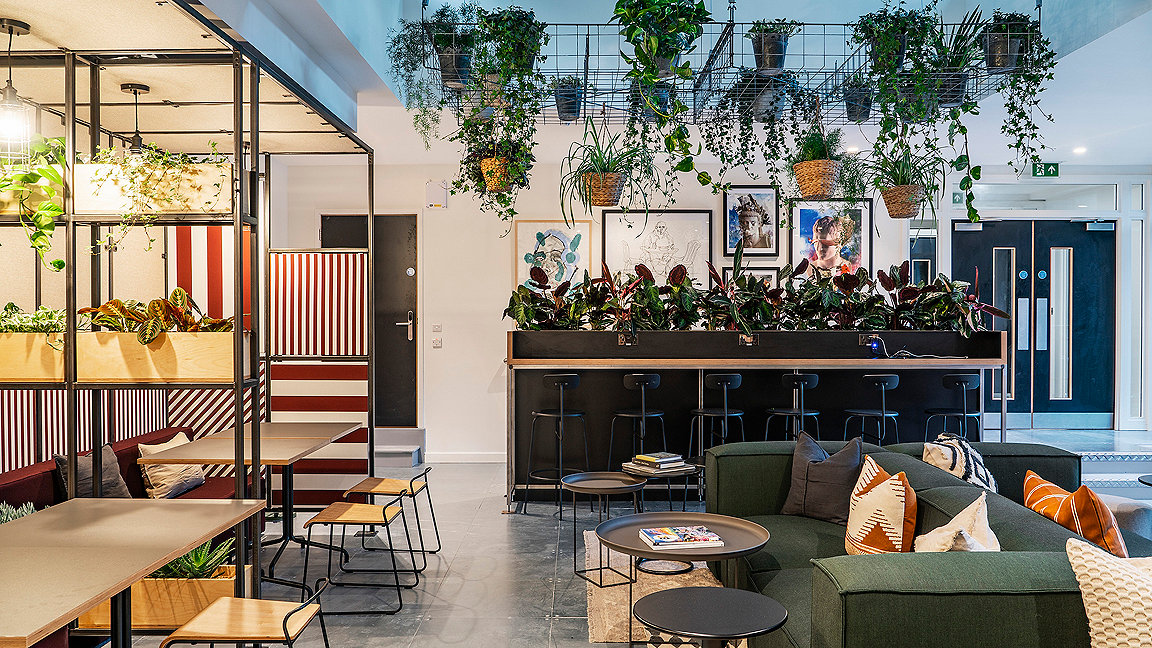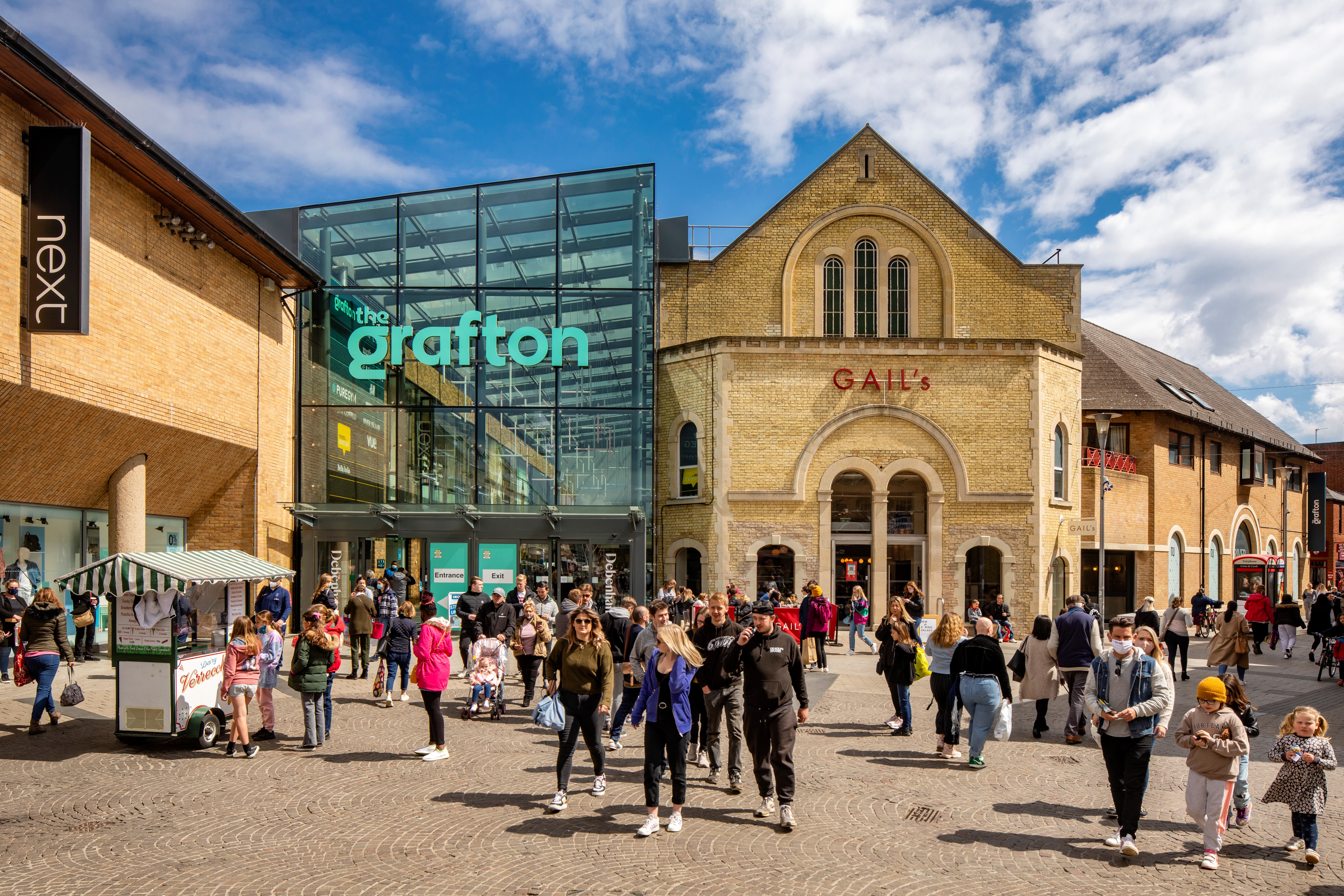
Interior of Grafton Centre flex workspace © x+why
John Lewis' announcement that eight of its stores will not reopen as lockdown restrictions lift, and the closure of all Debenhams' remaining stores, has added to the growing list of big-name casualties on the high street in the past 12 months. COVID-19 has accelerated the decline of bricks-and-mortar retail resulting from online-only shopping, and this trend looks set to continue.
Understandably, ailing retail landlords are now considering other asset classes, one of which could be particularly well positioned to save the high street from decline: flexible workspace. So-called flexspace can – indeed, has already begun to – provide a lifeline for landlords and their retail tenants by helping them adapt to changes in demand for office space, as well as offering tenants the opportunity to sublet their underused space for a much-needed injection of extra revenue.
Moreover, flexspace is better suited to accommodating the flux of growth businesses emerging from the pandemic, and it is a promising means of diversifying portfolios and local high streets – both of which have been placed under mounting pressure over the past year.
Meeting office space demand
An unprecedented wave of home working precipitated by the pandemic has not been the death of the office; rather, it is daily commuting that looks set to be the main work-related casualty of COVID-19. Retail landlords in regional centres are therefore ideally placed to profit from the changing expectations that businesses and their staff have for their workspace.
Before the pandemic, workers in the UK lost an average of 65 minutes each way to their daily commute, which adds up to more than ten days annually, or 492 days over the course of a working life.
Furthermore, with the average commuter spending £800 per year on these journeys, this amounts to a total lifetime expenditure of £37,000. With these figures in mind, it is unsurprising that so many workers would resist a return to traditional city-centre hubs, preferring easily accessible sites in local commercial centres instead.
But where to find these well-placed, well-resourced buildings? It would seem that, with the high street losing traditional retail business, these newly void spaces are ideal candidates for conversion into flexspace.
By partnering with experienced flexspace operators, who are well-versed in providing high-quality and suitable flexible office space, retail landlords can make this transition successfully, providing a workspace to which workers will want to return – and a refreshed source of revenue for themselves.
'It is unsurprising that so many workers would resist a return to traditional city-centre hubs, preferring easily accessible sites in local commercial centres instead'
Case study: Flexspace in the Grafton Centre
In February, L&G and flexspace provider x+why submitted plans for a new flexible workspace in Cambridge's Grafton Centre. The 1,400 sq m space will combine two former retail units to create the shopping centre's first offices.
The new serviced workspace will include private offices catering for teams, and open-topped desk pods for start-ups and entrepreneurs. This innovative project will be one of the first conversions of retail centres to flexible office space in the UK.
In addition to workspace, a second phase includes a further 750m2 level called the Galleries, incorporating two former restaurants. This will be dedicated to breakout, meeting and event spaces, as well as leisure, food and beverages.
The workspace will repurpose spare retail units to meet demand for offices in Cambridge, and encourage footfall in the Grafton Centre and surrounding area. Cambridge has one of the strongest and fastest-growing economies in the UK and demand for office space there has risen in recent years, with the sector benefitting from investment by venture capital firm Cambridge Innovation Capital, as well as an influx of life science and tech start-ups.
Tom Williams, fund manager at L&G, says: 'Repurposing excess retail space into alternative uses that change the rhythm of the asset is at the heart of the business plan. We are excited to be able to meet the rising demand for offices and champion retail at the same time.
'As retail continues to evolve, the new unit at the Grafton will help encourage footfall by putting potential customers on retailers' doorsteps five days a week, while giving Cambridge-based businesses a functional, well-designed space to grow.'
The offices will be fully fitted out by x+why. Its co-founder and CEO Rupert Dean comments: 'We're thrilled to be designing a flexible, serviced space that will cater to the needs of a variety of organisations and entrepreneurs and the ever-changing world of work.
'As the city continues to attract new and established businesses, and workers travel less, Cambridge is the ideal location for our first conversion of a retail centre into flexible workspace.'
He adds: 'We're very excited to play our part in meeting the demand for new workspace in the city. Repurposing the Grafton is not without its challenges, but we are determined to limit our environmental impact by making use of a space that already exists.
'This project will show that we don't always need to construct new offices – we can, and should, take purpose-built units and make them function for new uses that benefit surrounding businesses and workers themselves, placing them among amenities that promote a healthy work–life balance and encourage less overall travel.
'What is more, in addition to the workspaces there will be breakout areas of the scale and quality that one would expect in Google's or Amazon's headquarters, but available to even the smallest start-up businesses.'

Helping landlords and retailers
In addition to benefitting landlords, adopting flexspace can be a prime opportunity for retail tenants struggling to cope with the burden of underused or so-called grey space. Retailers can effectively sublet their surplus store space for alternative uses, which builds welcome diversification into their offerings.
Big-name players such as Selfridges and John Lewis have already begun exploring their options, with the latter examining alternative sources of revenue as varied as financial services and housing. Flexspace, though, may prove the best fit if the retail giant really intends to 'look at the right combination of options' and 'remain convenient for customers'.
Indeed, customers demand convenience now more than ever, and offering office space in the heart of their local commercial hubs is perhaps the most convenient proposition. Retail landlords and tenants with space to spare, therefore, can revitalise footfall in their stores by enabling workers to combine their work and leisure activities, such as shopping, with greater ease than ever.
A need for less rigidity
In the past 12 months, many landlords have started a dialogue with their tenants on the difficult issue of rent arrears, and rightly so. A similar frankness will need to permeate all aspects of doing business for landlords that hope to be successful after the pandemic.
It has indeed been extremely encouraging to see landlords and tenants working together to get through this crisis; but this willingness to adapt to the specific needs of individual tenants will be valuable beyond it as well.
Rather than offering rigid tenancy agreements, landlords should provide workspace that is flexible in terms of the lease length as well as the number of desks per tenant.
Incorporating this flexibility into their business models will also help landlords ensure their spaces appeal to a key market, namely the new generation of founders and fledgeling CEOs whose entrepreneurial energy will need a home beyond home working. Constraining these growth businesses with rigid, multi-year leases makes little long-term financial sense for any of the parties involved. Truly flexible workspace, however, provides an ideal solution.
Strategies for survival
Embracing diversification is a clear strategy for landlords in the current environment wanting to survive. This is true of any sector – but the wisdom of diversification has been underlined for commercial property landlords following the demise of both Arcadia and Debenhams in recent months.
But the transition from retail to flexspace is more than a shrewd business move, because it has the scope to improve consumers' quality of life as well as the prospects of the otherwise ailing UK high street. By diversifying the amenities available in traditional hubs, landlords can unlock the potential of these areas to be more than just the poor relation of increasingly popular online shopping.
High streets can therefore take the levelling-up agenda into their own hands, pivoting the amenities available to consumers to provide a basis for economic recovery and sustained growth through the greater footfall created by new workspaces.
Salvation for the high street?
Converting retail to flexspace can rejuvenate high streets in urgent need of new life, while also satisfying tenants' increasing demand for flexible fitted-out space that is conveniently located for a more desirable work–life balance.
Moreover, landlords will benefit from having diversified space, because it will help revenues remain more resilient and retention rates stay robust. As a solution that suits multiple parties, there are few more attractive alternatives than investing in flexible workspace.
Richard Morris is director at workspace tech firm technologywithin
Contact Richard: Email | LinkedIn
Related competencies include: Strategic real estate consultancy
